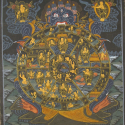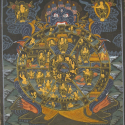Description
The Wheel of life (Sanskrit: bhava-chakra, Tibetan: srid pa’ikhor lo) painting is primarily a representation of the round rebirth and the various levels of sufferings within the round. It is traditionally placed outside the sanctuary of a Buddhist temple, in a place where a person entering a temple will see it.
Purpose of Wheel of Life
Thus the purpose of the Wheel of Life is to remind one of death and impermanence – that death is definite, the time of death is indefinite, and at the time of death nothing helps but religious practice.
In this way, the Buddhist is inspired to make effort at religious practice now while the opportunity is still present.
Found almost universally in the Buddhist temples of Tibet, Nepal, Bhutan, Sikkim, and Mongolia, the earliest example of this painting that has been found is at the Ajanta caves, dating to perhaps as early as a century before Christ. It is a marvelously informative and evocative work of art.
The story of the Wheel of Life painting
The story of the Wheel of Life painting is that Buddha himself designed it. At the time of Shakyamuni Buddha, the historical Buddha, one King Udayana made a present of a jeweled robe to King Bimbisara, who was unable to present to King Udayana a gift of equal value.
King Bimbisara consulted with his friend the Buddha about what he could give in return and Buddha described to him a painting showing the round of rebirth that he could have painted and present to King Udayana. Buddha also gave him the following stanzas to put with the painting:
- Undertaking this and leaving that.
- Enter into the teaching of the Buddha.
- Like an elephant in a thatched house.
- Destroy the forces of the Lord of death.
- Those who with thorough consciousness.
- Practice this disciplinary doctrine.
- Will forsake the wheel of birth.
- Bringing suffering to an end.
It is said that when the King received the picture and studied it, he gained nirvana or the enlightenment, which is freedom from the round of rebirth.
The Three Poison
The center of Bhavachakra contains 3 poison are:
- Ignorance (a pig)
- Aversion (a snake)
- Attachment (a bird)
It is these three that set the whole wheel in motion and lead to both negative and positive human action. The hellish and heavenly destinies are indicated by the semi-circles of black and white immediately surrounding the three animals.
Karma
The full circle represents Karma, the universal law of cause and effect. People on the dark path, through much disturbance, move down realms of existence while those on the bright path peacefully and smoothly keep moving up.
The Six Realms of Samsara
The third layer consists of six wedge-shaped sections, which are the realms of samsara (three higher and three lower). The upper half contains the three higher realms
- Deva realm (god realm),
- Asura realm (demi-god realm)
- Manuṣya (human realm)
The second half contains the three lower realms
- Tiryagyoni realm (animal realm)
- Preta realm (hungry ghost realm)
- Naraka realm (hell realm)
The first three are more pleasant but all six ultimately remain domains of suffering.
The gods, who in Buddhism are entities more powerful than human beings but undeserving of worship, are inclined to lives of pleasure and abundance.
The Twelve Links
The fourth layer of the Bhavachakra contains the Twelve Nidanas or “twelve links” or “twelve-fold chain” that demonstrates just how the three poisons, through karma, resulting in the six realms of samsara. Here the conditionality and causality of cyclical existence are shown in detail. These interdependent phenomena shed light on karma.
- Avidya lack of knowledge – a blind person, often walking, or a person peering out
- Saṃskara constructive volitional activity – a potter shaping a vessel or vessels
- Vijnana consciousness – a man or a monkey grasping a fruit
- Namarupa name and form (constituent elements of mental and physical existence) – two men afloat in a boat
- Sadayatana six senses (eye, ear, nose, tongue, body, and mind) – a dwelling with six windows
- Sparsa contact – lovers consorting, kissing, or entwined
- Vedanapain – an arrow to the eye
- Trisna thirst – a drinker receiving drink
- Upadana grasping – a man or a monkey picking fruit
- Bhava coming to be – a couple engaged in intercourse, a standing, leaping, or reflective person
- Jati being born – woman giving birth
- Jaramarana old age and death – corpse being carried
Yama
The four layers of the wheel are held by a huge, menacing figure. He is Yama, the lord of death, king of hell, god of the underworld, who symbolizes impermanence also known as Yamantaka.
His four limbs are the four sufferings of birth, sickness, old age, and death. His third eye means an understanding of impermanence. His third eye His crown of five skulls refers to the five aggregates, the functions or aspects of sentient beings:
- material form
- feelings
- perception
- volition
- sensory consciousness
THE BUDDHA AND THE MOON
Beyond the wheel, the Buddha stands pointing to the moon, the path of liberation. This can be called nirvana – the cessation of all unpleasant aches and pains.






























Reviews
There are no reviews yet.